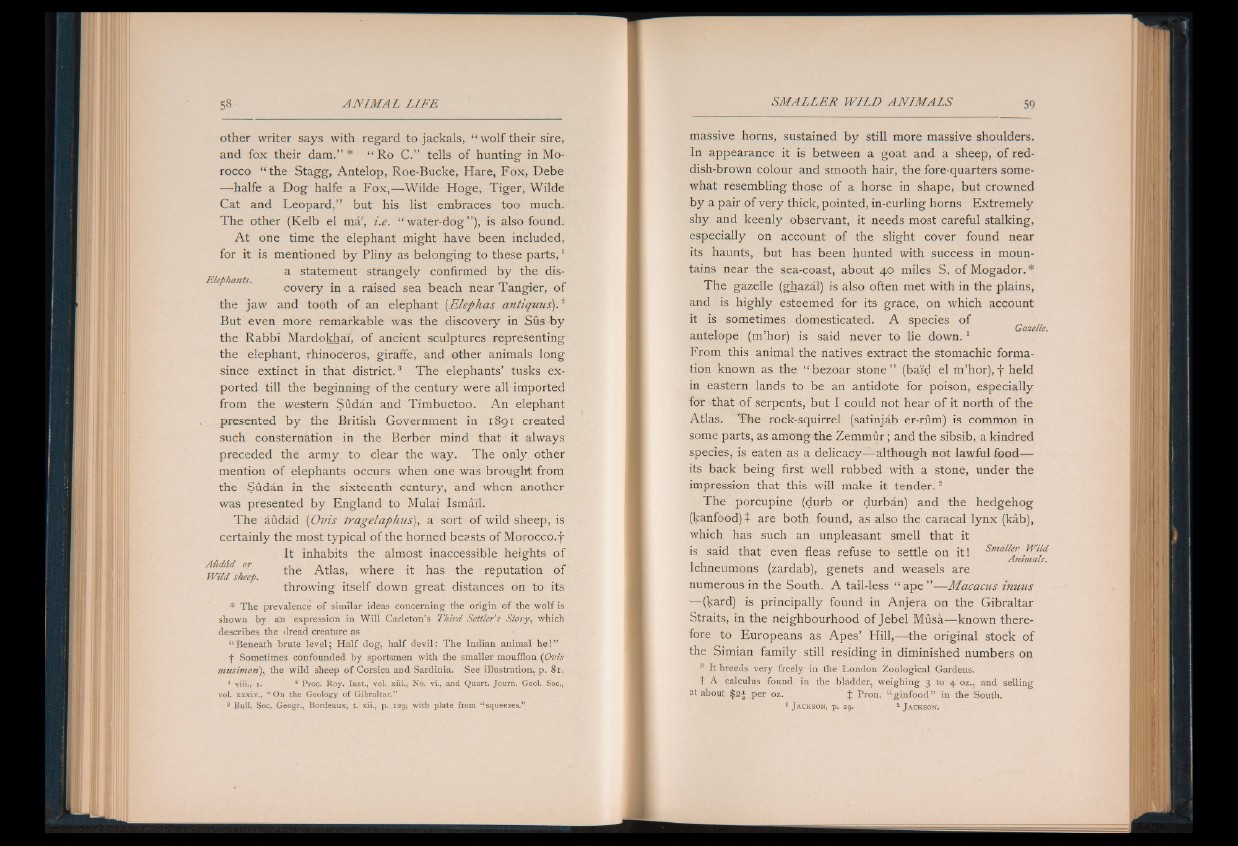
other writer says with regard to jackals, fg wolf their sire,
and fox their dam.” * “ Ro C.” tells of hunting in Morocco
“ the Stagg, Antelop, Roe-Bucke, Hare, Fox, Debe
— halfe a Dog halfe a Fox,— Wilde Hoge, Tiger, Wilde
Cat and Leopard,” but his list embraces too much.
The other (Kelb el ma', i.e. “ water-dog” ), is also found.
A t one time the elephant might have been included,
for it is mentioned by Pliny as belonging to these parts,1
a statement strangely confirmed by the dis-
Elephants. . . „ . 1 covery in a raised sea beach near iangier, of
the jaw and tooth of an elephant {Elephas antiquus).3
But even more remarkable was the discovery in Sus by
the Rabbi Mardokhai, of ancient sculptures representing
the elephant, rhinoceros, giraffe, and other animals long
since extinct in that district.3 The elephants’ tusks exported
till the beginning of the century were all imported
from the western Sudan and Timbuctoo. An elephant
presented by the British Government in 1891 created
such consternation in the Berber mind that it always
preceded the army to clear the way. The only other
mention of elephants occurs when one was brought from
the Sudan in the sixteenth century, and when another
was presented by England to Mulai Ismail.
The audad (Ovis tragelaphus), a sort of wild sheep, is
certainly the most typical of the horned beasts of M orocco.f
It inhabits the almost inaccessible heights of
'wifd sheep the Atlas, where it has the reputation of
throwing itself down great distances on to its
* The prevalence of similar ideas concerning the origin of the wolf is
shown by an expression in Will Carleton’s Third Settler s Story, which
describes the dread creature as
ftBeneath brute level; Half dog, half devil: The Indian animal he!”
Sometimes confounded by sportsmen with the smaller moufflon (Ovis
musimon), the wild sheep of Corsica and Sardinia. See illustration, p. 81.
1 viii., 1. 2 Proc. Roy. Inst., vol. xiii., No. vi., and Quart. Journ. Geol. Soc.,
vol. xxxiv., “ On the Geology o f Gibraltar.”
3 Bull, Soc, Geogr., Bordeaux, t. xii., p. 129*, with plate from “ squeezes,”
massive horns, sustained by still more massive shoulders.
In appearance it is between a goat and a sheep, of reddish
brown colour and smooth hair, the fore-quarters somewhat
resembling those of a horse in shape, but crowned
by a pair of very thick, pointed, in-curling horns Extremely
shy and keenly observant, it needs most careful stalking,
especially on account of the slight cover found near
its haunts, but has been hunted with success in mountains
near the sea-coast, about 40 miles S. ofMogador.*
The gazelle (ghazal) is also often met with in the plains,
and is highly esteemed for its grace, on which account
it is sometimes domesticated. A species of
1 3 , , Gazelle. antelope (m hor) is said never to lie down.
From this animal the natives extract the stomachic formation
known as the “ bezoar stone” (bal'd el m’hor), f held
in eastern lands to be an antidote for poison, especially
for that of serpents, but I could not hear o f it north of the
Atlas. The rock-squirrel (satinjab er-rum) is common in
some parts, as among the Zemmur; and the sibsib, a kindred
species, is eaten as a delicacy— although not lawful food—
its back being first well rubbed with a stone, under the
impression that this will make it tender.2
The porcupine (durb or durban) and the hedgehog
(kanfood)t are both found, as also the caracal lynx (kab),
which has such an unpleasant smell that it
is said that even fleas refuse to settle on itl Smaller Wild
Animats.
Ichneumons (zardab), genets and weasels are
numerous in the South. A tail-less “ ape ”— Macacus inuus
— (kard) is principally found in Anjera on the Gibraltar
Straits, in the neighbourhood of Jebel Musa— known therefore
to Europeans as Apes’ Hill,— the original stock of
the Simian family still residing in diminished numbers on
* It breeds very freely in the London Zoological Gardens,
t A calculus found in the bladder, weighing 3 to 4 oz., and selling
at about per oz. J Pron. ccginfood” in the South.
1 J a c k s o n , p . 2 9 . 2 J a c k s o n ,